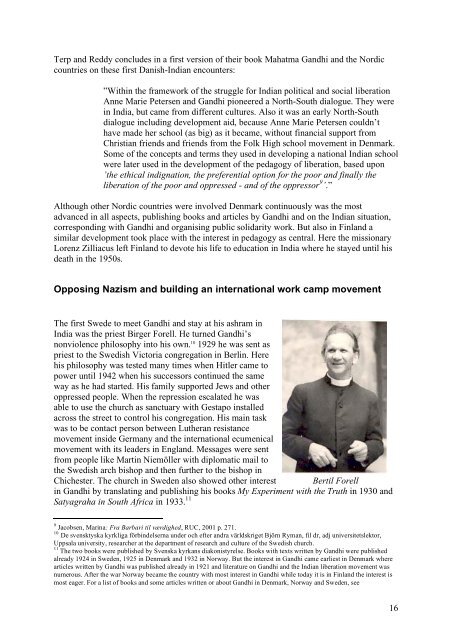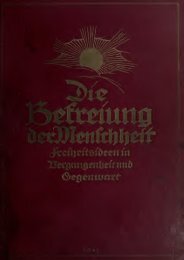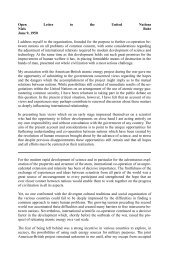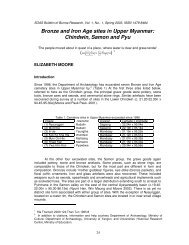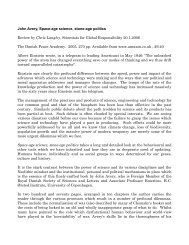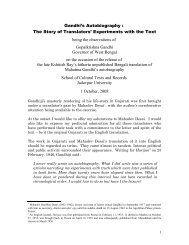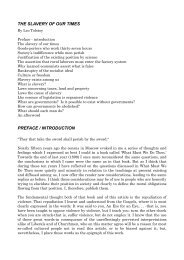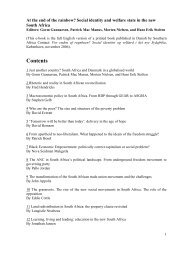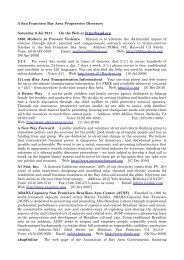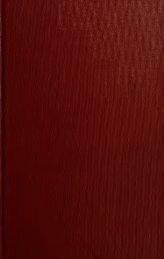Indian-Nordic Encounters 1917-2006 - Det danske Fredsakademi
Indian-Nordic Encounters 1917-2006 - Det danske Fredsakademi
Indian-Nordic Encounters 1917-2006 - Det danske Fredsakademi
You also want an ePaper? Increase the reach of your titles
YUMPU automatically turns print PDFs into web optimized ePapers that Google loves.
Terp and Reddy concludes in a first version of their book Mahatma Gandhi and the <strong>Nordic</strong><br />
countries on these first Danish-<strong>Indian</strong> encounters:<br />
”Within the framework of the struggle for <strong>Indian</strong> political and social liberation<br />
Anne Marie Petersen and Gandhi pioneered a North-South dialogue. They were<br />
in India, but came from different cultures. Also it was an early North-South<br />
dialogue including development aid, because Anne Marie Petersen couldn’t<br />
have made her school (as big) as it became, without financial support from<br />
Christian friends and friends from the Folk High school movement in Denmark.<br />
Some of the concepts and terms they used in developing a national <strong>Indian</strong> school<br />
were later used in the development of the pedagogy of liberation, based upon<br />
’the ethical indignation, the preferential option for the poor and finally the<br />
liberation of the poor and oppressed - and of the oppressor 9 ’.”<br />
Although other <strong>Nordic</strong> countries were involved Denmark continuously was the most<br />
advanced in all aspects, publishing books and articles by Gandhi and on the <strong>Indian</strong> situation,<br />
corresponding with Gandhi and organising public solidarity work. But also in Finland a<br />
similar development took place with the interest in pedagogy as central. Here the missionary<br />
Lorenz Zilliacus left Finland to devote his life to education in India where he stayed until his<br />
death in the 1950s.<br />
Opposing Nazism and building an international work camp movement<br />
The first Swede to meet Gandhi and stay at his ashram in<br />
India was the priest Birger Forell. He turned Gandhi’s<br />
nonviolence philosophy into his own. 10 1929 he was sent as<br />
priest to the Swedish Victoria congregation in Berlin. Here<br />
his philosophy was tested many times when Hitler came to<br />
power until 1942 when his successors continued the same<br />
way as he had started. His family supported Jews and other<br />
oppressed people. When the repression escalated he was<br />
able to use the church as sanctuary with Gestapo installed<br />
across the street to control his congregation. His main task<br />
was to be contact person between Lutheran resistance<br />
movement inside Germany and the international ecumenical<br />
movement with its leaders in England. Messages were sent<br />
from people like Martin Niemöller with diplomatic mail to<br />
the Swedish arch bishop and then further to the bishop in<br />
Chichester. The church in Sweden also showed other interest Bertil Forell<br />
in Gandhi by translating and publishing his books My Experiment with the Truth in 1930 and<br />
Satyagraha in South Africa in 1933. 11<br />
9 Jacobsen, Marina: Fra Barbari til værdighed, RUC, 2001 p. 271.<br />
10 De svensktyska kyrkliga förbindelserna under och efter andra världskriget Björn Ryman, fil dr, adj universitetslektor,<br />
Uppsala university, researcher at the department of research and culture of the Swedish church.<br />
11 The two books were published by Svenska kyrkans diakonistyrelse. Books with texts written by Gandhi were published<br />
already 1924 in Sweden, 1925 in Denmark and 1932 in Norway. But the interest in Gandhi came earliest in Denmark where<br />
articles written by Gandhi was published already in 1921 and literature on Gandhi and the <strong>Indian</strong> liberation movement was<br />
numerous. After the war Norway became the country with most interest in Gandhi while today it is in Finland the interest is<br />
most eager. For a list of books and some articles written or about Gandhi in Denmark, Norway and Sweden, see<br />
16


